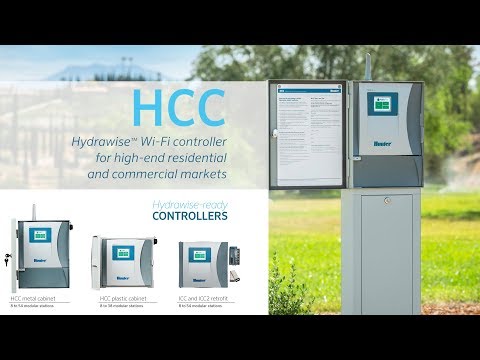
Hunter HCC Hydrawise™ 8 Station Modular WIFI Commercial Irrigation Controller and Modules (Expandable to 54 Stations)
Hunter HCC 8 Station Modular Wifi Outdoor Controller
| DOWNLOAD PRODUCT BROCHURE |
The Hunter HCC Hydrawise™ Controller is a next-generation commercial irrigation solution that combines the robust features of the popular ICC2 with the smart, Wi-Fi-based management of Hydrawise™. Built for large residential, commercial, and public-sector projects, the HCC ensures powerful performance, flexible expandability, and intelligent water savings.
The HCC can control up to 54 stations and operate two stations plus a pump/master valve simultaneously, making it ideal for complex irrigation systems. Its modular design supports 4-, 8-, and 22-station expansion modules, as well as two-wire decoder output with Hunter’s EZ-1 decoders or Wireless Valve Link modules, giving you flexible installation options.
Featuring an 8 cm full-colour touchscreen interface, the HCC makes programming intuitive both with and without Wi-Fi connectivity. Once connected, Hydrawise Predictive Watering™ uses real-time weather data to automatically adjust schedules based on rainfall, temperature, wind, and humidity—helping save water while keeping landscapes healthy.
For enhanced monitoring, the HCC is HC Flow Meter compatible, offering instant leak detection, high/low flow alerts, and total system water usage reports. A built-in milliamp sensor ensures quick diagnosis of wiring issues, reducing downtime and service costs.
Prewired with a SmartPort® harness, the HCC also supports Hunter ROAM and ROAM XL remotes for long-range manual operation without needing a smartphone. With multiple enclosure options—plastic, metal, stainless steel, and pedestal—the HCC provides unmatched versatility for a wide range of installations.
BENEFITS
- Modular and expandable: 8 to 38 stations (plastic), 8 to 54 stations (metal/pedestal)
- Two-wire decoder option with EZ-1 Decoders or Wireless Valve Link
- Runs any 2 stations plus pump/master valve simultaneously
- Hydrawise™ Predictive Watering™ for daily weather-based schedule adjustments
- 8 cm full-colour touchscreen for simple programming
- Built-in milliamp sensor for wire fault detection and alerts
- Flow monitoring with optional HC Flow Meter
- Prewired SmartPort® for ROAM and ROAM XL remote compatibility
- Enclosure options: outdoor plastic, metal, stainless steel, or pedestal
SPECIFICATIONS
- Input: 120/230 VAC
- Output: 24 VAC, 1.4 A
- Station output (24 VAC): 0.56 A
- Pump/Master valve output (24 VAC): up to 0.56 A
- Sensor inputs: 2











